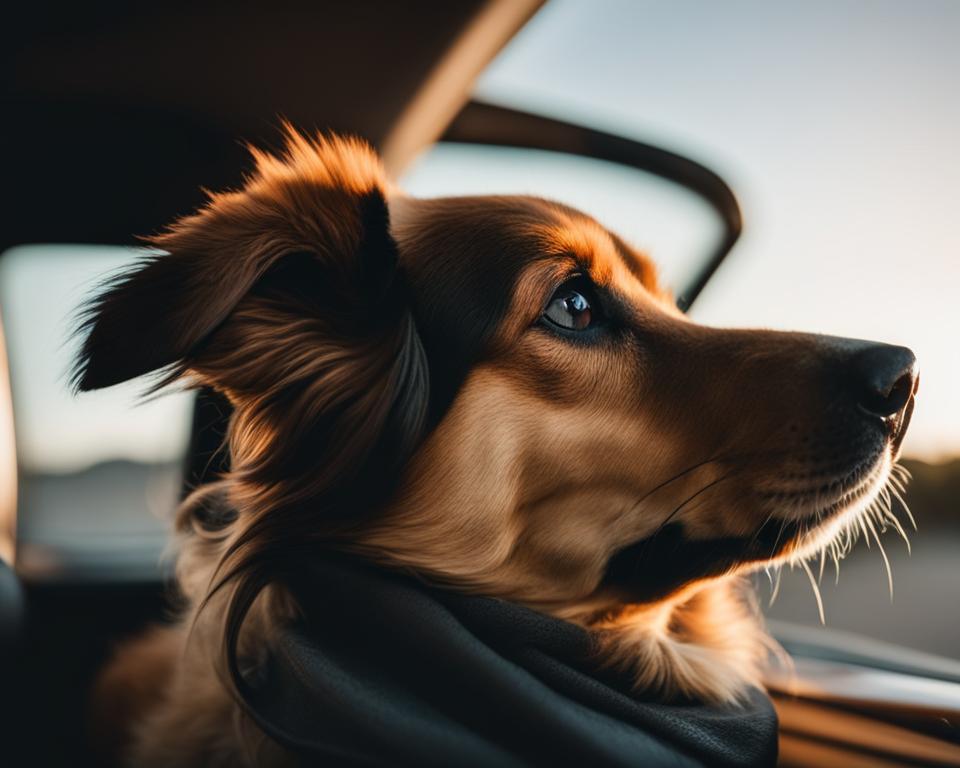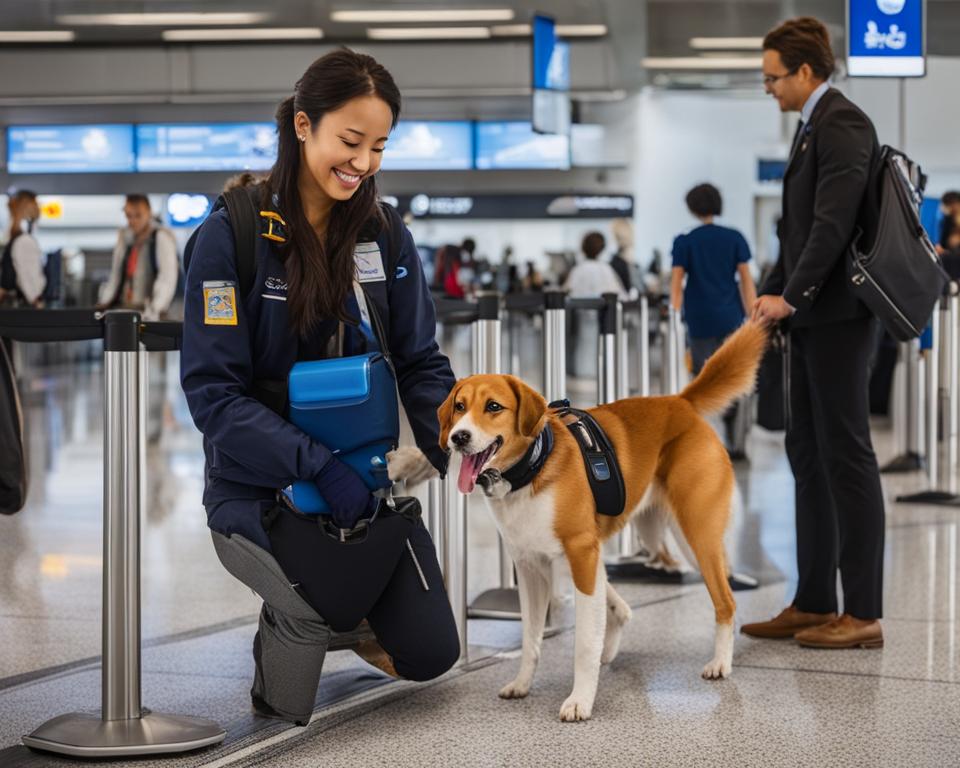Embarking on a vacation and considering bringing along your furry family member? Incorporating your canine into travel plans is more just packing a dog toy—it’s about ensuring a memorable and hassle-free experience. To help, we’ve gathered expert tips for traveling with dogs that cover everything from health to hospitality. Whether you’re hitting the open road or taking to the skies, our dog-friendly travel advice is designed to pave the way to a seamless journey with your four-legged companion. With these best practices for traveling with dogs, you can undertake an adventure that’s enjoyable for both of you!
Key Takeaways
- Scheduling a health check before departure ensures your dog’s fitness for travel.
- Proper identification, including microchipping, aids in recovering your dog should they get lost.
- A well-ventilated travel crate is a must-have for safe and comfortable dog transportation.
- Familiarize your pooch with travel conditions gradually to minimize stress and anxiety.
- Selecting dog-friendly accommodations beforehand makes for a better overall experience.
- Planning your dog’s travel kit can mitigate unforeseen circumstances and keep tails wagging.
Preparing Your Dog for Travel: Health and Identification
Ensuring that your furry friend is ready for travel involves key steps, such as securing their health and identification. From the nourishment they need to the assurance of their safety, each detail plays a vital role in how to travel with dogs stress-free. Let’s explore these essential tips for traveling with your furry friend to guarantee a smooth experience for both of you.
Pre-Travel Veterinary Checkup and Vaccination Records
It’s imperative to begin your preparations with a visit to the veterinarian. This step is crucial not only to ensure your dog’s vaccinations are current but also to confirm they are physically and mentally primed for the journey ahead. Obtain a health certification if needed, especially for air travel, and always carry a copy of your dog’s vaccination records.
Choosing the Right Dog Crate for Safe Transportation
To make your travel with your dog as safe and comfortable as possible, selecting the right crate is a cornerstone of planning. Not all crates are made equal; they should be spacious enough for your companion to stand, turn, and lie down, but also sturdy, with a leak-proof bottom to protect against accidents. A well-ventilated crate marked with a “Live Animal” label and your contact information is crucial for ensuring stress-free travel conditions for your pet.
| Crate Feature | Benefits |
|---|---|
| Size | Allows dog to move comfortably |
| Leak-Proof Bottom | Keeps crate clean and dry |
| Ventilation | Ensures fresh airflow |
| Labels & Identification | Helps with handling and safety |
Ensuring Proper Identification and Documentation
A sturdy collar with up-to-date tags is non-negotiable for peace of mind. These tags should include your dog’s name, your contact details, and proof of rabies vaccination. Consider microchipping as an additional safety measure—it’s a more permanent form of identification. Additionally, bring along a recent photograph of your dog and their health records. Such preparatory steps are instrumental in facing any unforeseen situations confidently.
By meticulously navigating these preliminary procedures, you’ll be setting the stage for an enjoyable trip with your canine companion, epitomizing the essential tips for traveling with your furry friend and mastering how to travel with dogs stress-free.
Expert Tips for Traveling with Dogs on Road Trips
As you prepare for a road adventure with your four-legged friend, making their journey comfortable is as important as ensuring they are part of the fun. Discover our top tips for a dog-friendly vacation, tailored to create lasting memories and a wagging tail throughout your trip.

Acclimating Your Dog to Car Travel
The best road trips with your dog start with familiarization. Begin with short rides around the neighborhood and slowly build up to longer distances. This gradual increase helps your pet adapt to the motion and sound of the vehicle, reducing stress and anxiety. Remember, positive experiences during these trial runs can make all the difference during the actual trip.
Managing Food and Water Intake to Prevent Carsickness
To dodge the unpleasant experience of carsickness, have your dog travel on an empty stomach. Yet, hydration remains key, so make sure fresh water is always accessible. By managing your dog’s eating schedule and water intake, you’re mitigating discomfort and making the car ride smoother for everyone involved.
Essential Items for a Dog Travel Kit
Your dog’s travel kit should be nothing short of comprehensive. Beyond the basics of food and water, include any medications your pet needs, familiar toys to offer comfort, and clean-up supplies for any roadside stops. Safety takes precedence; therefore, a crate or dog seatbelt is imperative to keep your furry companion secure. Above all, never leave your pet alone in the car, especially in extreme weather conditions, as it can pose serious risks to their health.
| Item | Use |
|---|---|
| Travel Crate or Dog Seatbelt | Keeps dog secure and safe during travel |
| Bottled Water | Prevents stomach upset from unfamiliar water sources |
| Medications | Ensures pet health management |
| Comfort Toys | Provides familiar comfort to ease stress |
| Clean-Up Supplies | Handles any necessary cleanups en route |
Embedding these travel dos and don’ts into your planning will pave the way for a tranquil and enjoyable excursion with your furry travel companion. Keep these expert pointers in mind as you venture out on your next dog-friendly road trip!
Guidelines for Flying with Dogs: From Cabin to Cargo
Preparing to fly with your canine companion can be complex, but with expert advice on traveling with your dog, you can navigate the skies with confidence. This section will cover everything you need to know about airline policies, essential health certifications, and preparing your dog for their flight, ensuring you both arrive at your destination stress-free. Always factor in extra time for preparation, as accommodating the various rules and requirements is paramount for a successful trip with your dog.

Understanding Airline Requirements and Restrictions
Airlines enforce specific guidelines for pet travel, and understanding these can be the difference between a smooth flight and a travel hiccup. The cost for your dog to join you in the cabin typically ranges from $95 to $125, dependent on the airline’s policy. Size and breed restrictions can apply, which is why it’s crucial to know and comply with the airline’s regulations well ahead of your departure date. Start your trip preparations early, particularly if you are considering international or inter-state travel with your dog. Following these essential tips for a successful trip with your dog will help ensure compliance and a pleasant journey for your pet.
Essential Health Certificates and Flight Preparations
When planning to fly with your dog, health and safety are paramount. An up-to-date health certificate is often required by airlines, verifying that your furry pal is fit for air travel. This certificate typically should be issued within ten days before flying. Be prepared to also show proof of your dog’s rabies vaccination and any other required immunizations. Your preparation checklist should include an airline-compliant pet carrier labeled “Live Animal” with your contact details prominently displayed. This, paired with early planning and adherence to essential tips for traveling with your dog, ensures a safe and worry-free flight for both you and your pet.
| Airline Requirement | Description | Traveler Action Items |
|---|---|---|
| Pet Carrier/Crate | Durable, ventilated, correctly sized | Purchase compliant carrier, label with contact info |
| Health Certification | Issued within 10 days of flight | Visit vet to obtain certificate and update vaccinations |
| Booking and Fees | Varies by airline, size, and breed restrictions | Confirm booking for pet, prepare for associated costs |
| Destination Regulations | Varies by state/country | Research destination rules, prepare documentation |
By diligently following this expert advice and preparing accordingly, you’ll be fully equipped for a high-flying adventure with your loyal dog by your side. Remember, the more prepared you are, the smoother the trip will be, ensuring a joyful and stress-free travel experience for you both.
Traveling with Dogs by Train, Bus, or Boat
While road trips and flights are common choices for pet owners, navigating alternative modes of transport can require additional planning. Whether you’re eyeing a leisurely journey by rail or a voyage across the sea, understanding the nuances of traveling with pets aboard trains, buses, and boats is essential. Our curated dog-friendly travel advice will help you consider all transportation options when traveling with your four-legged friends.

In the realm of rail travel, Amtrak has opened doors for small dogs, allowing those under 20 pounds to come aboard for an additional fee. This presents an opportunity for owners of petite pooches to enjoy the scenic rails. Before boarding, be sure to familiarize yourself with Amtrak’s specific policy on pet travel, including their kennel requirements and fees, to ensure a smooth trip.
If your journey involves bus travel, you might encounter more restrictions. Most interstate bus services, like the widely-known Greyhound, generally do not permit dogs except for service animals. It’s critical to research local and regional bus lines for their individual rules regarding pets on board.
For those considering a nautical adventure, your options can vary greatly. Certain cruise lines welcome dogs, allowing you to set sail with your companion by your side. The pet guidelines can differ by cruise line and ship, so advanced planning is vital. In some cases, pets might be restricted to onboard kennels, while other cruises may permit your dog to stay in the cabin with you.
Confirm pet policies in advance with your chosen cruise line, and check if they provide amenities like on-deck walking areas or in-cabin pet services.
Exploring beyond domestic borders with your dog can be an enriching experience, but it requires thorough preparation. Researching international pet travel regulations should be a priority, as each destination will have its own set of rules, health certifications, and potential quarantines that could impact your travel plans.
- Confirm pet policies with transportation providers well in advance.
- Contact customer service for detailed traveling with pets tips and requirements.
- Understand and comply with pet-related fees and documentation needs.
When plotting a journey with your pet that includes trains, buses, or boats, planning far ahead is key. By doing so, you not only ensure compliance with pet travel regulations but also contribute to a more enjoyable travel experience for you and your dog.
Accommodation Strategies: Dog-Friendly Hotels and Lodging
Finding a place to stay on vacation isn’t only about the views or the amenities—it’s also about making sure it’s suitable for your furry friend. Securing dog-friendly hotels and lodging requires a bit of research and understanding of their pet policies. But don’t fret, here are some essential tips for traveling with your furry friend and making sure your stay is pleasant for both you and your pup.

Puppy-Proofing Your Room for a Stress-Free Stay
Just like childproofing, puppy-proofing your hotel room can save you from unwanted surprises and ensure your dog’s safety. Check for any loose wires, accessible trash bins, or hazardous items within paw’s reach. By creating a safe space, you allow your dog to explore their new environment without worry. Remember to bring their favorite blanket or toy to give them a sense of familiarity.
Rules and Etiquette for Staying with Dogs in Hotels
Observing proper etiquette is one of the top tips for a dog-friendly vacation. Keep your dog as quiet as possible, and make sure they are supervised at all times. Inquire about the designated areas for walks and always clean up after your dog. By being a considerate guest, you contribute to a welcoming atmosphere for pet owners and encourage hotels to maintain their pet-friendly policies.
| Tip | Description | Benefit |
|---|---|---|
| Research Pet Policies | Review the hotel’s specific pet guidelines | Avoids surprises and prepares for any additional fees |
| Puppy-Proofing | Scan the room for potential hazards | Ensures dog’s safety and prevents damage | Supervision | Never leave your dog unattended | Prevents noise complaints and accidents |
| Cleanup | Bring supplies to take care of messes | Keeps room and hotel grounds clean |
By adhering to these guidelines and preparing ahead, your vacation with your furry companion will be more enjoyable and less stressful. Remember, your actions can have a lasting impact on the hotel’s pet policy, making it crucial to leave a positive impression. So pack your dog’s bag, book the right hotel, and get ready for a fantastic dog-friendly vacation!
Conclusion: A Joyous Journey with Your Canine Companion
As we wrap up our comprehensive guide, it’s clear that harnessing expert tips for traveling with dogs forms the backbone of a delightful and smooth experience. Undertaking a well-planned trip with your four-legged friend takes more than a leash and a love for adventure; it requires attention to their individual needs and comfort. By following best practices for traveling with dogs, from ensuring a familiar and safe journey in their crate to securing dog-friendly lodging, you’re setting the stage for travels that are as stress-free as they are memorable.
Yet, amidst the bustling excitement of adventure, recall that each dog possesses their own unique persona. While some may leap with tail-wagging enthusiasm for a car ride, others might find greater happiness in staying within the familiar, quiet corners of home. Understanding and respecting your dog’s preferences is a testament to the loving bond between pet and owner. No matter where the road takes you, your dog’s wellbeing is paramount and echoes the lasting sentiment of your trip together.
You’re now equipped with the knowledge to transform any vacation into an epic escapade with your furry family member. Whether you’re navigating city streets or traversing mountaintops, embrace the shared moments and nurture the exploration spirit with your beloved pup. The ultimate goal? Creating joyful memories that resonate beyond any single journey, for both you and your favorite travel partner.
FAQ
How should I prepare my dog for travel?
Prioritize a visit to the vet to ensure all vaccinations are up-to-date and to discuss your dog’s fitness for travel. Get health certificates if required, especially for air travel, and make sure your dog is gradually accustomed to their travel crate or harness.
What is the best type of crate for transporting my dog safely?
Choose a well-ventilated crate with a leak-proof bottom, big enough for your dog to stand, turn, and lie down comfortably. It should also be labeled with “Live Animal,” and your contact information, and be sturdy enough to protect your dog during transit.
How can I ensure my dog’s identification is secure while traveling?
Equip your dog with a well-fitted collar, up-to-date identification tags, and a microchip. Carry a recent photo and health documentation to help locate your dog in case you get separated. Verify that all details on tags and microchips are current.
What are some tips for acclimating my dog to car travel?
Start with short drives to get your dog used to the motion of the vehicle. Gradually increase the length of time spent in the car, and use positive reinforcement to create a stress-free association with vehicle travel.
How can I manage my dog’s food and water to prevent carsickness?
Avoid feeding your dog a large meal before traveling. Instead, offer a light meal a few hours before departure and ensure they have access to water. During the trip, provide small amounts of food and water at regular intervals.
What essentials should I include in my dog’s travel kit?
Pack enough dog food for the entire trip, bottled water, any necessary medications, a waste scoop and bags, a first aid kit, and comfort items like your dog’s favorite toy or blanket.
What do I need to know about airline travel with my dog?
Research the airline’s specific pet policies, including size and breed restrictions, and fees. You’ll need a suitable carrier and health certificates. Familiarize yourself with the country and state pet import laws if you’re traveling internationally or across state lines.
How can I find dog-friendly hotels and what should I consider when booking?
Research hotels that welcome pets and understand their policies regarding fees, size limitations, and available amenities. Book your stay in advance to ensure availability and inquire about areas designated for dog walking and relief.
Are there special considerations for dogs while staying in hotel rooms?
Keep your dog supervised and practice quiet time to avoid disturbing other guests. Puppy-proof your room to avoid accidents, and use designated areas for your dog’s bathroom breaks. Always clean up after your dog to maintain a good relationship with the hotel.
Can I travel with my dog by train, bus, or boat?
Options for traveling with dogs on public transportation are limited and vary by company. Amtrak allows small dogs for a fee, while most buses only allow service animals. For boat travel, check with the cruise line or carrier for their specific pet policies.

